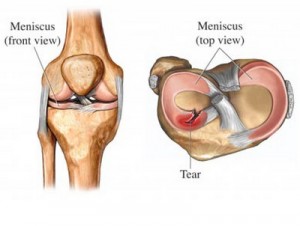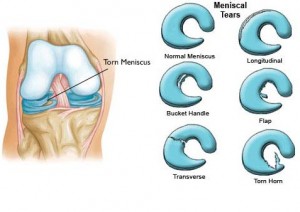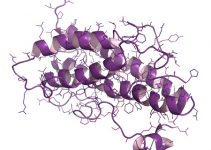Torn Meniscus
The knee joint has a fibrocartilaginous crescent-shaped structure that serves to distribute the weight of the body uniformly across the three bones that compose the knee joint namely the tibia (shin bone), femur (thigh bone) and the patella (knee cap). This structure is called the meniscus and aside from providing stability, it also acts as a spacer between the knee bones allowing them to move effectively without resulting to any damage.
There are two menisci in each knee between the surfaces of the articular cartilage: the medial meniscus (at the inner section) and the lateral meniscus (at the outer section). These structures also act as shock absorbers during jumping, running or walking between the tibia and femur. A meniscus tear would produce an unequal distribution of the body weight. The large central portion of the meniscus is not supplied directly by blood vessels, thus, any injury to this area would often fail to heal since oxygen and nutrients would not reach it.
Meniscus Tear
When the knee is forcefully rotated while supporting weight, a meniscal tear would develop. This usually happens among athletes who play contact or field sports like football and soccer; or any vigorous pivoting or twisting activities or sports such as basketball, tennis, skiing or martial arts. The risk of meniscal tear also increases with age due to deterioration or degenerative tear.
Torn Cartilage
Both the meniscus and the covering of the knee bone peripheries are cartilages making the problem quite confusing. When people would speak of “cartilage”, they would be referring to either the meniscus or the articular cartilage. However, when a torn knee cartilage is being referred to, they are discussing a meniscus tear. When they are talking about deterioration of cartilage or arthritis, they are referring to the articular cartilage.
A torn cartilage in the knee would happen when the femoral condoyle is forcefully rubbed to the tibial plateau during a vigorous twist or abrupt stop. Another reason for a torn knee cartilage is when a person does deep squatting or kneeling particularly when lifting up a very heavy weight. An increasing body weight would add additional stress to the meniscus and would eventually end up with a torn cartilage in the knee.
Medial Meniscus Tear
Between the two menisci, the medial meniscus is more likely to be injured ten times more than the lateral meniscus. This is because it is attached to the joint capsule and medial collateral ligament, giving it less mobility. Any force coming from the external environment can cause a severe medial meniscal tear and would usually necessitate surgical intervention.
A torn medial meniscus can be caused by an application of any abnormal pressure to the medial meniscus pushing it between the knee bones. This would usually happen when a bent knee is twisted when the force is applied.
There are different types of torn medial meniscus: Bucket handle (longitudinal bucket-shaped tear), horizontal, radial (from the edge to the inside), complex and parrot beak tears. The severity of the medial meniscal tear would depend on the type, the zone of injury and size of the tear. If the injury occurred at the area where there is less blood supply, then the healing process is encumbered.
Lateral Meniscus Tear
The lateral meniscus has fewer attachments therefore it can slip around the top of the tibia. So a torn lateral meniscus is less likely to occur if abnormal pressure is applied to it as this cartilage can move more freely. But, nevertheless, a lateral meniscal tear can still occur with repetitive direct pressure to the knee joint or abrupt changes in direction and sudden twisting movements especially in combination with too much bending or straightening of the knee while the foot is flat on the ground.
There are two types of lateral meniscal tear: the longitudinal and the bucket-handle tears.
Torn Meniscus Pictures
Picture 2: Types of Meniscal tears
Torn Meniscus Symptoms
The common symptoms of torn meniscus are swelling and pain. Individuals experiencing this problem would also complain of joint locking or the inability to straighten the knee joint completely which is usually a result of a torn cartilage interrupting the knee’s joint mechanism. Some would also feel a popping sensation.
Other symptoms of torn meniscus include:
- Tenderness at the joint line
- A generally weak knee that buckles with weight
- Limited knee joint motion
These symptoms of torn meniscus would usually resolve over time for slight injuries. But if the knees are severely inflamed and the pain is severe, medical help should be obtained.
Torn Meniscus Pain
The pain felt with meniscus tear is usually caused by the inflammation of the surrounding tissues of the knee. A small tear can cause minimal pain during the initial stage of the injury. As swelling develops, pain might increase slightly and is felt during movement such as rising from a seat, lifting or squatting. The pain usually fades away in two to three weeks or if the swelling has subsided.
Torn Meniscus MRI
The MRI is particularly effective in inspecting glitches in the meniscus. It would give high-quality images of the size and location of the meniscal tears. This diagnostic test is painless and would not require needles or any special dyes.
Torn Meniscus Treatment
Initial treatment for torn meniscus is RICE: Rest, Ice, Compression and Elevation. This would help lessening the inflammation. Anti-inflammatory medicines may also be given to help relieve the inflammation and the pain that goes with it. Once the inflammation has been resolved, exercises that help strengthen the surrounding muscles should be started to support and stabilize the knee joint. Use of arch supports or shoe inserts would help facilitate the distribution of the weight equally around the knee and decrease the stress on the affected part.
Larger tears would need a different treatment plan. In cases like these, the treatment for torn meniscus would require surgical intervention. Regrettably, only around one in four meniscal tear can be mended by surgery.
Torn Meniscus Surgery
A good number of operations are made by arthroscopy where a minute camera is introduced into the knee joint via a small incision and surgical tools are inserted on another small incision. The camera allows the surgeon to see the whole joint and repair or remove the frayed meniscus. The surgeon would try to save as much as possible a bigger portion of the original meniscus.
Other surgical treatment for torn meniscus would include partial meniscectomy where a part of the torn cartilage is cut out or trimmed to even out the surface. Sometimes, the worn meniscus is stitched back together with tacks or sutures. Rarely will the entire meniscus be removed.
Meniscus transplant are now slowly being introduced. In this procedure, the cartilage is replaced with a donor tissue. An innovative procedure where meniscal implants is being introduced. Implants from natural substances are made and the person’s cells are allowed to proliferate into it. This procedure is not available or done in most health facilities.
Torn meniscus surgery recovery time would depend on the extent of the damage on the meniscus. Some people could quickly get back to their routine activities while others may have less joint inflammation but still find it difficult to perform normal activities of daily living.
Torn Meniscus Recovery
After an arthroscopic surgery, a person with a sedentary job may return a week or two after the surgical procedure and full recovery is often experienced after 4 to 8 weeks. An athlete that needs a great deal of physical activity would need 3 to 4 months of torn meniscus surgery recovery time before the full function of the knee is recovered.
Partial meniscectomy would require 4 to 6 weeks rest period before an individual can go back to doing their normal activities. It the meniscus was partially repaired, 4 to 6 months recovery time is expected. For ACL reconstruction, aggressive rehab program is needed and full recovery is expected after 6 to 9 months. However, if the person has a desk job, returning to work would be allowed within one to two weeks.
Torn Meniscus Exercise
A person is encouraged to perform regular moderate exercises even before the knee has fully recovered. Activities that would place further stress or weight on the affected knee is not allowed until it has fully recovered. Non-weight bearing exercises such as swimming and cycling are firmly encouraged.
Knee Exercises for Torn Meniscus
Knee exercises can help in the recovery of a torn meniscus. The initial phase of the exercise should be slow and free of pain – do not wear out the knee. Keep in mind that the exercises are done to lessen the pain so they should be done progressively.
Stretching exercises would include: hamstring stretch, quadriceps stretch, heel slide and knee press. Strengthening exercises should also focus on hamstring, quadriceps, and abductor muscles. Static contractions on these muscles would help prevent their degeneration and weakening especially on the acute phase of the injury. Other strengthening exercises would include straight leg raises, knee extension, leg curl, hip and calf raises, hip adduction and abduction exercises, and squatting.
If inflammation starts to come back, the exercise should be discontinued for at least two to three days to give the muscles some rest. If no relief is felt after eight to ten days of doing these exercises then proper consultation should be done.
References:
http://www.mayoclinic.com/health/torn-meniscus/DS00932
http://www.medicinenet.com/torn_meniscus/article.htm





